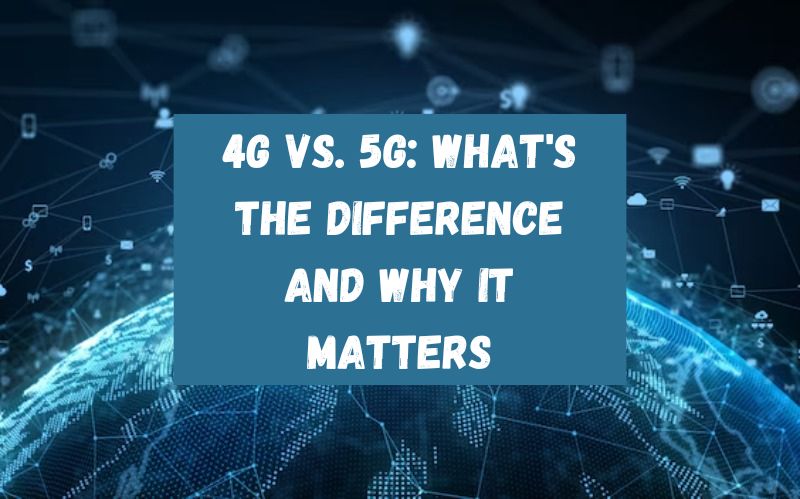The world of mobile connectivity is rapidly evolving, and you’ve probably heard a lot about 5G in the past few years. But what exactly is 5G, and how does it differ from 4G? To answer these questions, let’s break down the key differences between these two generations of mobile networks and explore why 5G is a game-changer for technology and connectivity.
What Is 4G?
4G, or Fourth Generation, is the mobile network technology that most of us use today. It’s been around since 2009 and has revolutionized the way we use mobile devices, providing high-speed internet, video streaming, and seamless communication on the go. 4G networks offer speeds that can reach up to 1 Gbps (Gigabit per second) under optimal conditions, though in practice, users typically experience speeds closer to 10-100 Mbps (Megabits per second).
4G enabled many of the services we rely on today, such as HD video calls, streaming services like Netflix and YouTube, and mobile gaming. It transformed the way we interact with our devices, making everything from navigation to entertainment faster and more convenient.
What Is 5G?
5G is the fifth generation of mobile network technology, designed to provide significantly faster speeds, lower latency, and more reliable connections than 4G. While 5G networks are still being rolled out around the world, they promise to revolutionize not just how we use our phones, but how industries, cities, and technologies operate.
5G promises speeds of up to 10 Gbps—10 times faster than the theoretical maximum of 4G. But it’s not just about speed. 5G also offers lower latency (as low as 1 millisecond), which means faster response times and less lag. This is particularly important for real-time applications like remote surgery, autonomous vehicles, and augmented reality (AR).
Key Differences Between 4G and 5G
1. Speed
The most obvious difference between 4G and 5G is speed. 5G is significantly faster than 4G. With 5G, downloading a full-length HD movie could take mere seconds, while 4G might take several minutes. 5G also supports faster upload and download speeds, making it ideal for high-demand tasks like streaming ultra-high-definition videos, large file transfers, and cloud-based gaming.
2. Latency
Latency refers to the delay in sending and receiving data between devices. 5G networks are much faster in terms of latency compared to 4G. While 4G has a latency of around 30-50 milliseconds, 5G can reduce that to under 1 millisecond. This low latency is crucial for time-sensitive applications like autonomous vehicles, where instant communication is needed to avoid accidents, or for industrial robots that require precise coordination.
3. Capacity
One of the most important aspects is its ability to handle a lot more devices simultaneously. 4G networks could handle thousands of devices per square kilometer, but 5G can support over a million devices in the same space. This is key for the rise of the Internet of Things (IoT), where everyday objects like smart fridges, wearable devices, and connected vehicles need a network to communicate.
4. Network Efficiency
5G is designed to be more efficient than 4G, making it capable of managing high-demand data traffic more effectively. This is particularly important as the number of connected devices continues to grow and the demand for mobile internet rises. 5G’s efficiency enables it to handle large amounts of data without overloading the network, offering more reliable connections in crowded areas.
5. Coverage and Availability
Although 5G promises faster speeds and greater capacity, its rollout is still in progress. Initially, 5G coverage will be concentrated in urban areas and specific zones, but as infrastructure improves, 5G will expand to more locations. In contrast, 4G is already widely available around the world and offers more stable coverage in rural and remote areas.
Why Does 5G Matter?
Beyond faster internet speeds, 5G opens the door to a new world of possibilities that 4G simply can’t support. Let’s take a look at some of the key innovations enabled by 5G:
1. Autonomous Vehicles
Self-driving cars need real-time data and communication with nearby vehicles, road sensors, and traffic management systems to make safe decisions. 5G’s ultra-low latency ensures that autonomous vehicles can process this information nearly instantly, enabling safe navigation on busy roads.
2. Smart Cities
5G is set to power the cities of the future, enabling everything from smart traffic lights that adjust based on real-time traffic patterns, to energy-efficient buildings that adjust heating, lighting, and cooling based on occupancy and weather data. With this, a vast network of connected devices will make urban life more efficient and sustainable.
3. Enhanced Augmented and Virtual Reality (AR/VR)
For AR and VR experiences to be truly immersive, they require high-speed internet and ultra-low latency. 5G enables seamless, real-time interactions with virtual environments, making it ideal for applications in gaming, training, remote work, and even remote healthcare.
4. Healthcare Innovation
5G technology can revolutionize healthcare through telemedicine, remote surgeries, and real-time health monitoring. With its low latency and high bandwidth, 5G can support remote surgeries, allowing surgeons to perform operations from anywhere with the help of robotic surgery tools controlled in real-time.
The Bottom Line
While 4G has served us well, 5G is the next step in the evolution of mobile networks. It’s not just about faster download speeds—5G will enable entirely new technologies, industries, and ways of life that were previously unimaginable. From connected cities to autonomous vehicles and beyond, 5G is opening up a world of opportunities, creating a more efficient, sustainable, and connected future.
As 5G networks continue to roll out, it’s clear that they will bring far-reaching changes not only to how we use our phones but to every industry that relies on connectivity. So, the next time you’re browsing your phone or streaming a video, remember: the future of connectivity is just getting started!











